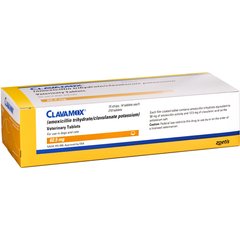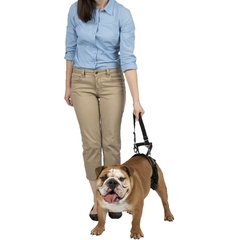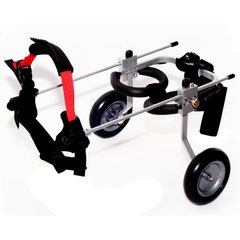Why Is My Dog Losing Balance? How To Help a Wobbly Dog

Photo by Chewy
Don’t dismiss your dog’s loss of balance as a minor dizzy moment. A wobbly dog could be experiencing a serious medical issue, and it’s your job to sniff it out.
Here are the most common conditions that lead to a dog falling over or stumbling, and what to expect.
Key Takeaways
- Loss of balance in dogs can stem from many causes, including ear infections, IVDD, hypothyroidism, toxin exposure, or neurological conditions.
- Other warning signs—like head tilt, vomiting, or rapid eye movement—can help your vet pinpoint the problem.
- Prompt veterinary care is critical to diagnose the cause and prevent permanent damage.
- At home, focus on safety and comfort—remove hazards, provide traction, and support your dog’s mobility during recovery.
Why Is My Dog Stumbling?
When dogs experience a loss of coordination, it’s called ataxia.
Ataxia is essentially a miscommunication between the brain, spinal cord, or inner ear, says Carly Fox, DVM, a senior veterinarian in the Emergency & Critical Care Department at the Schwarzman Animal Medical Center in New York City.
Here are some of the most common reasons your dog is wobbly and might lose their sense of balance.
IVDD
Spongy discs provide cushion between the vertebrae of the spine, but these discs can bulge or burst and put pressure on the spinal cord, a condition known as intervertebral disc disease (IVDD). The pressure on the spinal cord can cause pain and nerve damage that might result in a dog losing balance in the hind legs or even cause paralysis.
Head Trauma
If trauma damages a part of the brain that is responsible for balance, your dog may not be able to coordinate their movements. This type of head trauma is usually from extreme circumstances like being hit by a car or falling from a significant height.
Hypothyroidism
Hypothyroidism, a disease that causes low thyroid hormone, can affect the nervous system. Some of these changes disrupt a dog’s sense of balance or cause neuropathy that leads to muscle weakness and a dog losing balance in their rear legs first, before total loss of coordination if left untreated.
Inner Ear Infection
The inflammation that results from an inner ear infection can interfere with your dog’s equilibrium, causing them to lose their sense of balance.
You might also notice your dog tilting or shaking their head. Don’t delay treatment; an unresolved ear infection can lead to a permanent loss of balance (and/or hearing).
Idiopathic Vestibular Disease
While ear infections can cause issues, so can other more significant ear conditions where the cause is unknown.
Idiopathic vestibular disease is seen most commonly in senior canines. The vestibular system is responsible for regulating your dog’s sense of balance, and it’s centered around the function of the middle ear and inner ear and parts of the brain that control movement.
Stroke
When a dog has a stroke, a blood vessel in the brain ruptures or becomes blocked. This cuts off the supply of oxygen-rich blood to the brain and causes stroke symptoms, like a dog falling over to one side or showing a loss of coordination.
Brain Tumor
A mass or tumor that puts pressure on areas of a dog’s brain that control and coordinate movement, like the brainstem or cerebellum, could cause a dog to have trouble standing or walking.
Drug Ingestion
Neurological problems can be a side effect if your dog has ingested drugs like marijuana or nicotine. Over-the-counter medicines, like antidepressants, blood pressure medication, and diuretics, also carry the risk of ataxia. That’s why it’s so important to keep medications safely locked away from prying noses or paws.
Toxin Exposure
Ingesting—or even inhaling—some common household chemicals, like rodenticides, can cause ataxia, says Brian Collins, DVM, a veterinarian with the Cornell Richard P. Riney Canine Health Center.
If your dog ingests any type of drug or toxin, contact your vet or the Pet Poison Helpline at 855-764-7661 immediately.
Cerebellar Hypoplasia
This condition’s hallmark symptom is wobbliness, but most pups don’t know they’re any different than other dogs. With a pet parent’s support, they can thrive.
Wobbler Syndrome
Wobbler syndrome also causes an unsteady gait, but it can be very painful for pups. It’s more common in large-breed dogs and requires an urgent trip to your vet’s office.
Other Symptoms To Look Out For
A loss of balance in your dog might be the first or most obvious sign that something is not right with your dog, but there are others.
These include:
- Nausea
- Drooling
- Vomiting
- Head tilt
- Rapid eye movement
- Falling to one side
- Walking in circles
- Dragging of the limbs
- Change in mental state
- Seizures
“Symptoms may be gradual and subtle at first—or they may come on acutely and dramatically,” says Dr. Collins. He suggests taking a video of your dog’s movements, if possible, to share with your veterinarian.
What To Expect at the Vet for a Wobbly Dog
How Your Vet Will Diagnose Your Pup
Your veterinarian will review your dog’s medical history, perform a physical exam, and run diagnostic tests, which might include blood work, a urinalysis, or X-rays.
“Examinations and testing will help differentiate true causes of ataxia from other conditions that cause weakness or collapse that may look like balance problems, including metabolic problems, such as low blood sugar, or heart disease,” Dr. Collins says.
A referral to a veterinary neurologist may be recommended for a conclusive diagnosis.
Treatment for a Wobbly Dog
Treatment depends on what’s causing your dog’s wobbliness and may include:
- Antibiotics for an infection
Recommended Products
- Anti-inflammatory meds for inflammation or swelling
Recommended Products
- Medicated ear treatments
- Surgery if there is a problem with the spinal cord or a tumor is discovered
- Fluid therapy if your dog ate something toxic
- Any combination of these, in addition to other treatment
What’s Your Dog’s Prognosis?
A loss of balance can be temporary for some dogs and long-lasting or permanent for others.
For example, ataxia caused by an ear infection might resolve when the underlying cause is treated. In other cases, ataxia might become an ongoing condition that is managed with medications, precautions regarding physical activity, and/or surgery, as with dogs diagnosed with IVDD.
Experts say that prompt treatment from a veterinarian is crucial for the best chance of recovery. With that in mind, seek veterinary care as soon as you notice that your dog is wobbly.
How Can You Help Your Dog at Home?
After your dog has been evaluated by a veterinarian, focus on increasing your pet’s comfort and safety at home, depending on the cause and course of treatment:
Help them easily get from place to place
Remove hazards, like anything difficult for them to get around or maneuver and try exercise mats or runners to provide extra traction on slippery floors.
It’s important to block access to stairs while your dog is recovering, as the risk of them falling is very high until they have successfully been treated. Some causes might require a permanent solution while others might be temporary.
Consider a dog gate, like the Frisco Steel Extra Tall Dog Gate, so that your dog can avoid stairs during recovery.
Recommended Products
Give them lots of rest
Your vet might recommend crate rest for your wobbly dog to minimize movement and allow for healing, especially with IVDD.
A crate should be roomy enough for your dog to turn around comfortably but small enough to keep them from jumping, pacing, or moving around excessively. A crate like Frisco’s Heavy Duty Fold & Carry Dog Crate allows your pup to get cozy while also providing enough paw room to move around.
Recommended Products
Make sure to include a dog crate pad, like Frisco’s Quilted Dog Crate Mat, as well as a blanket to keep your dog cozy (as long as they won’t chew and eat it!).
Recommended Products
Give your dog mobility support if they need it
Your vet can best guide you, but this might include slings, dog wheelchairs, or a dog stroller—anything that helps your bestie get out and about.
A harness, instead of a neck collar, is a great way to protect your dog’s back and neck if they have IVDD. Other mobility aids can help your dog be steadier on their feet or have easier mobility.
Recommended Products
FAQs About Dogs Losing Balance
Can you prevent loss of balance in dogs?
In some cases, early detection and prompt intervention may help—for example, if you intervene early on with an ear infection. However, there is no way to fully protect against loss of balance depending on the underlying cause.
Should I take my dog to the vet if he is wobbly?
Yes, take your dog to the vet if they’re wobbly, and do it as soon as possible.
Why is my dog acting drunk all of a sudden?
While they might seem uncoordinated or “drunk,” your dog’s wobbliness or ataxia is serious. Their brain, spinal cord, or inner ear may be affected, so seek veterinarian help right away.

















